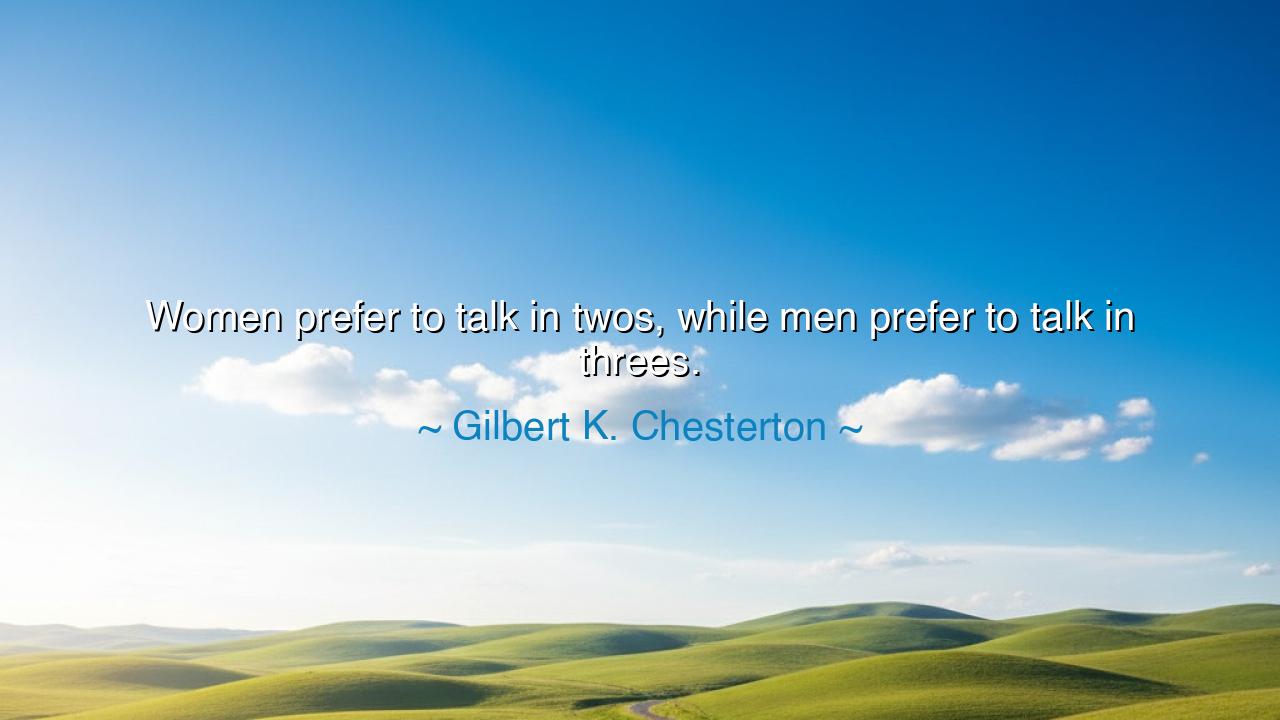
Women prefer to talk in twos, while men prefer to talk in threes.






When Gilbert K. Chesterton wrote, “Women prefer to talk in twos, while men prefer to talk in threes,” he was not describing a trivial social quirk — he was revealing an ancient truth about the nature of communication, intimacy, and the human soul. Beneath his humor lies a deep understanding of the different rhythms of connection between men and women. For Chesterton, conversation was not merely words exchanged, but a reflection of the soul’s architecture — how we build meaning, trust, and understanding. In this quote, he draws a gentle line between the intimacy of two and the energy of three, between communion and contest, between the feminine instinct to unite and the masculine instinct to test.
The ancients knew that dialogue is sacred. In the old Greek academies, philosophers gathered in small circles — not to chatter, but to awaken truth through exchange. Yet they also saw how men and women approached conversation differently. Women, said the sages, speak to connect, while men speak to define. In the company of two, a woman opens the gates of feeling, listening with the heart as much as the ear. The pair becomes a mirror, each soul reflecting the other’s depths. Men, meanwhile, are drawn to triads — for the third presence brings tension, competition, balance. It is in the triangle that they test ideas, clash egos, and forge camaraderie. Thus, Chesterton’s jest carries the wisdom of millennia: women build bridges through one-to-one communion; men build tribes through the dynamics of three.
Look to the myths of old and see how this pattern lives. The goddess Athena, wise and solitary, revealed her truths to a single mortal at a time — teaching patience, virtue, and clarity. Yet Odysseus, the hero, rarely acted alone; he debated with his crew, sparred with kings, and matched wits with rivals. The feminine impulse, like Athena’s, seeks understanding through intimate exchange; the masculine impulse, like Odysseus’s, seeks truth through challenge and movement. Neither is superior — both are vital. The one brings peace, the other progress. But when a society loses either — when women’s deep dialogues are silenced or men’s spirited debates are suppressed — the balance of wisdom falters.
Chesterton lived in an age of transformation, when the roles of men and women were shifting under the weight of modernity. He observed that women’s natural genius for emotional and moral discernment was being undervalued, even mocked. In celebrating the way women “talk in twos,” he was not condescending, but admiring. He saw in their closeness a form of truth that the modern world — obsessed with noise and numbers — too easily overlooked. The quiet intimacy of two souls speaking sincerely holds a depth that a crowd can never reach. In such moments, one heart recognizes another, and the invisible is made visible.
There is a great story that illustrates this. Florence Nightingale, the mother of modern nursing, was known for her compassion and intellect. Yet what sustained her through endless nights of war and sickness was not the applause of nations, but the intimate counsel of a few trusted friends — conversations whispered in confidence, reflections shared between two spirits of faith. Her strength came not from public discourse, but from personal communion — the sacred “two” that Chesterton honors. Through such companionship, the human spirit renews itself; through such honest dialogue, civilization is healed.
But Chesterton also understood the necessity of the three. For men, the third presence prevents stagnation; it transforms friendship into philosophy. The great thinkers of the past — Socrates, Plato, and Aristotle — spoke always in groups, where debate sharpened truth. The tension between three minds keeps the fire alive, ensuring that no single thought becomes a tyranny. Thus, men’s love of threes is not vanity, but vitality — an instinct to keep ideas breathing. Through this balance of intimacy and debate, humanity finds both compassion and clarity.
And so, the lesson of Chesterton’s reflection is this: learn to honor both the dialogue of two and the discourse of three. There are times to speak heart to heart — to listen, to heal, to understand. And there are times to gather with others — to argue, to refine, to discover. One nourishes love; the other strengthens wisdom. To live well is to know when to seek one, and when to seek the other.
Let us, then, preserve both forms of speech. Speak as women do, in pairs of trust and empathy; speak as men do, in circles of challenge and discovery. For in the stillness of two, the heart finds its truth — and in the clash of three, the mind finds its light. And when heart and mind unite in harmony, the world itself grows wiser.






AAdministratorAdministrator
Welcome, honored guests. Please leave a comment, we will respond soon